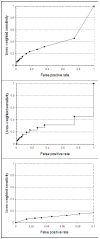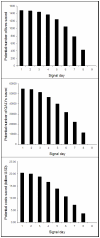Use of outcomes to evaluate surveillance systems for bioterrorist attacks
- PMID: 20459679
- PMCID: PMC2876990
- DOI: 10.1186/1472-6947-10-25
Use of outcomes to evaluate surveillance systems for bioterrorist attacks
Abstract
Background: Syndromic surveillance systems can potentially be used to detect a bioterrorist attack earlier than traditional surveillance, by virtue of their near real-time analysis of relevant data. Receiver operator characteristic (ROC) curve analysis using the area under the curve (AUC) as a comparison metric has been recommended as a practical evaluation tool for syndromic surveillance systems, yet traditional ROC curves do not account for timeliness of detection or subsequent time-dependent health outcomes.
Methods: Using a decision-analytic approach, we predicted outcomes, measured in lives, quality adjusted life years (QALYs), and costs, for a series of simulated bioterrorist attacks. We then evaluated seven detection algorithms applied to syndromic surveillance data using outcomes-weighted ROC curves compared to simple ROC curves and timeliness-weighted ROC curves. We performed sensitivity analyses by varying the model inputs between best and worst case scenarios and by applying different methods of AUC calculation.
Results: The decision analytic model results indicate that if a surveillance system was successful in detecting an attack, and measures were immediately taken to deliver treatment to the population, the lives, QALYs and dollars lost could be reduced considerably. The ROC curve analysis shows that the incorporation of outcomes into the evaluation metric has an important effect on the apparent performance of the surveillance systems. The relative order of performance is also heavily dependent on the choice of AUC calculation method.
Conclusions: This study demonstrates the importance of accounting for mortality, morbidity and costs in the evaluation of syndromic surveillance systems. Incorporating these outcomes into the ROC curve analysis allows for more accurate identification of the optimal method for signaling a possible bioterrorist attack. In addition, the parameters used to construct an ROC curve should be given careful consideration.
Figures




Similar articles
-
Assessing surveillance using sensitivity, specificity and timeliness.Stat Methods Med Res. 2006 Oct;15(5):445-64. doi: 10.1177/0962280206071641. Stat Methods Med Res. 2006. PMID: 17089948
-
Decision theoretic analysis of improving epidemic detection.AMIA Annu Symp Proc. 2007 Oct 11;2007:354-8. AMIA Annu Symp Proc. 2007. PMID: 18693857 Free PMC article.
-
Detection and early identification in bioterrorism events.Fam Community Health. 2008 Jan-Mar;31(1):4-16. doi: 10.1097/01.FCH.0000304063.94829.92. Fam Community Health. 2008. PMID: 18091080 Review.
-
An evaluation model for syndromic surveillance: assessing the performance of a temporal algorithm.MMWR Suppl. 2005 Aug 26;54:109-15. MMWR Suppl. 2005. PMID: 16177701
-
Real-time syndrome surveillance in Ontario, Canada: the potential use of emergency departments and Telehealth.Eur J Emerg Med. 2004 Feb;11(1):3-11. doi: 10.1097/00063110-200402000-00002. Eur J Emerg Med. 2004. PMID: 15167186 Review.
Cited by
-
The potential economic value of a Staphylococcus aureus vaccine among hemodialysis patients.Vaccine. 2012 May 21;30(24):3675-82. doi: 10.1016/j.vaccine.2012.03.031. Epub 2012 Mar 29. Vaccine. 2012. PMID: 22464963 Free PMC article.
-
Integration of syndromic surveillance data into public health practice at state and local levels in North Carolina.Public Health Rep. 2012 May-Jun;127(3):310-7. doi: 10.1177/003335491212700311. Public Health Rep. 2012. PMID: 22547862 Free PMC article.
-
The current state of bioterrorist attack surveillance and preparedness in the US.Risk Manag Healthc Policy. 2014 Oct 9;7:177-87. doi: 10.2147/RMHP.S56047. eCollection 2014. Risk Manag Healthc Policy. 2014. PMID: 25328421 Free PMC article. Review.
-
Mathematical models and analysis tools for risk assessment of unnatural epidemics: a scoping review.Front Public Health. 2024 May 2;12:1381328. doi: 10.3389/fpubh.2024.1381328. eCollection 2024. Front Public Health. 2024. PMID: 38799686 Free PMC article.
References
-
- Henning KJ. What is syndromic surveillance? MMWR Morb Mortal Wkly Rep. 2004;53(Suppl):5–11. - PubMed
-
- Kleinman KP, Abrams A, Mandl K, Platt R. Simulation for assessing statistical methods of biologic terrorism surveillance. MMWR Morb Mortal Wkly Rep. 2005;54(Suppl):101–108. - PubMed
-
- Kleinman KP, Abrams AM. Assessing surveillance using sensitivity, specificity and timeliness. Stat Methods Med Res. 2006;15(5):445–464. - PubMed
Publication types
MeSH terms
Grants and funding
LinkOut - more resources
Full Text Sources
Medical

